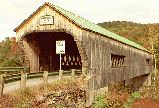Bartonsville Covered Bridge |
|
|
Site: V06-51
|
National Register Nomination Information:
DESCRIPTION: The Bartonsville Covered Bridge consists of a single span supported by two flanking timber Town lattice trusses. The floor of the bridge has been recently reinforced with two laminated stringers that extend the length of the bridge, evenly spaced between the trusses. Each laminated stringer of short timbers is tie-bolted together. The abutments of the bridge are built of stone slabs without mortar. Guy cables stretch from the southeastern and northeastern corners of the bridge to the river banks laterally reinforcing the superstructure. The Bartonsville bridge is 151 feet long on the floor, with a gable overhang of about four feet at each end. The bridge is 19 feet wide, with a 15.5-foot roadway. On the exterior, the large planks pegged together diagonally to form the trusses (and side walls) of the bridge are sheathed with flush boards hung vertically. A narrow rectangular opening in the siding near each corner of the bridge except the northeastern provides better visibility of on-coming traffic (including trains at the southern end). The gable overhangs give additional protection against weathering of the exposed timbers inside the portals. The gables are also sheathed with flush boards hung vertically. The roof of the bridge is covered with corrugated metal sheeting.
One of three original covered bridges remaining in the town of Rockingham, the Bartonsville bridge is the largest at 151 feet. Its single span, which measures 159 feet between portal over hangs measured across the top of the trusses, ranks a close second to the longest single timber span in the state. Sanford Granger of Westminster, the most prominent bridge builder in northern Windham County, finished the Bartonsville bridge in 1871. The bridge is the largest surviving example of his work. Vermont's covered bridges are among tile state's most cherished and symbolic historic resources. About one hundred bridges still stand in the state, probably the greatest concentration by area of covered bridges in the country.(1) Many of these bridges are integral parts of unique architectural environments whose physical setting and cultural context have been little altered until recently. However, extensive highway construction programs are now drastically changing the historic environment of the state. The Vermont Division of Historic Sites hopes to extend the recognition and protection of the National Register to the majority of the surviving covered bridges, including the Bartonsville bridge.
NOTES:
Morse, Victor (rev. by R. S. Allen). Windham County's Famous Covered Bridges, The Stephen Greene Press, Brattleboro, Vt., 1960.
DATE ENTERED: July 2, 1973.
|
BACK TO NATIONAL REGISTER PROPERTIES
